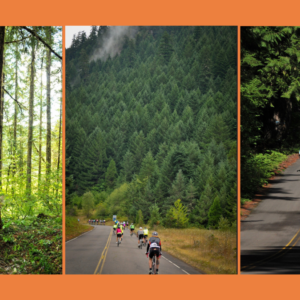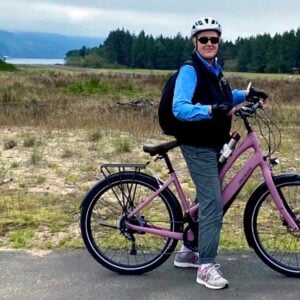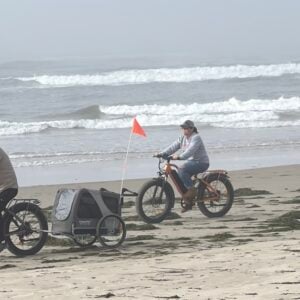Two things have recently come to my attention that have got me thinking the answer to this question might just be, Yes!
First, comes news that the premier issue of Road Bike Action magazine has a blurb about the Oregon racing scene that calls the state a “racing hotbed.”
The article goes on to say that,
“If you happen to live in the Portland area, from the first week in June to the second week in July, you could race seven days a week.”
Check out a jpeg of the article (102 kb).
The other sign came by way of an informational flyer about Oregon racing that recently came across my desk. It contains some persuasive factoids:
- No other state comes close in number of racers per capita (we are 3rd for total racers behind CA and CO).
- The Oregon Bicycle Racing Association (OBRA), is the national model for state bike-racing associations.
- The Cascade Classic is the oldest continuous road race in the U.S.
- We have hosted the Cycle Cross National Championships.
- The Cross Crusade is the largest participatory cyclocross racing series in the world.
- The entire country of Belgium is the only place in the planet that has more cycle cross racers than Oregon.
- The Alpenrose Challenge (held every year in southwest Portland) boasts one of the largest prize lists in North America.
- OBRA promotes the only six-day race in the U.S.
- Oregon has the second-highest number of total events (only eight behind California, but they have 30 million more people).
I’ve raced mountain, road and cyclocross in Oregon and have always found the events to be fun and well-managed.
Is it safe to say Oregon is tops? Can anyone compare it with California or Colorado’s racing scene?








Thanks for reading.
BikePortland has served this community with independent community journalism since 2005. We rely on subscriptions from readers like you to survive. Your financial support is vital in keeping this valuable resource alive and well.
Please subscribe today to strengthen and expand our work.
Don’t forget Oregon’s other impressive race credentials:
-Portland’s near-constant barrage of alleycat races.
-Portland is the only US city to host alleykittens (alleycats on 16″ bikes).
-Home of the world’s largest post-apolcalyptic chariot race.
-Home of the worlds only minibike century (Yes. 100 miles on a mini.).
Oregon is tops if you are taking into account measures of participation and fun.
“Racing scene” needs to be qualified as either the above or as a place that has great elite level competition.
Oregon has a deficit in the scene when it comes to top competition – that is where other places can outpace us. The fun guage is sadly in opposition to the attitudes that are necessary for creating a very competitive elite scene (we should all be happy to not have that!).
And Oregon is home to the hardest RAAM qualifier in the country. Race Across Oregon!www.raceacrossoregon.com.
John,
elite vs. fun. that’s a great topic. I agree they are usually mutually exclusive.
Racing organizations that focus on the best riders really lack the participation by normal people that makes for what I consider a vibrant (and viable) racing scene.
I think the best measure is the number of racers and number of events. In the grand scheme of things, the number of elite level riders a state produces is secondary.
I’m grateful that OBRA’s leaders (Mike and Candi Murray) focus on fun and participation over everything else.
As someone who raced her very first time trial ever at the age of 45 on a beat-up steel bike in this year’s Jack Frost, I for one am very happy that Oregon’s race scene has room for folks like me that just want to have fun.
The only way to get the “next big thing” to come from Oregon is to get the “next big thing” on the bike and racing. Inclusiveness does that. Good on ya, OBRA!
The racing community in Oregon is tops and the scene in Portland alone should be something other cities should aspire to be. It’s a great model.
This is coming from someone who recently moved to Charlotte, NC; former Portland racer.
JeremyE,
You and Jonathan are both right on the money.
It does take a huge body of participants to allow for great riders to come up – simply a matter of statistics and talent over time.
Jonathan hit the nail on the head though, that the “fun” things that we all like about OBRA racing and the cut-throat nature of elite cycling are most often mutually exclusive.
Upon reaching the cusp between “good local rider” and “O.K. national level rider,” those thousands of participants no longer do a young rider any good. In fact, I would argue that they do harm (to a burgeoning career) by making this a safe and fun place to be – thus making it difficult to leave for rougher waters.
Top talent – which we certainly produce – will always fail to develop unless it is challenged by better riders. We are lacking that really strong, deep, elite local level of rider (in cross, road, track, mtn…) that is required to push talented youngsters to become the cream of the crop.
That said, I am more than happy to live here and I’m glad that our young riders aren’t being pushed too hard – even if it means they won’t progress to be “top” world class racers.
I raced extensively in CA throughout the 80’s and Portland definitely has a better racing scene than anything I experienced down South. While the training in CA (especially the Santa Barbara area) can be much better, the racing here is efinitely more accessible and much better organized (thanks OBRA!).
I too raced in CA thoughout the 80s and the scene there is still much the same. Compared to Oregon, CA races are more intense and technical, particularly the criteriums. Here in Oregon the Criterium schedule is pretty much a joke (no, PIR is not a real Criterium, but Healthnet is). In So. Cal you could typically pick from two criteriums each weekend with fields of Olympians, pros, and national team members from the US and beyond. Prize lists are much more respectable too. While Oregon has some respectable riders, the depth and talent in California is heads above what’s here. Even the races and rides in CA, such as the biweekly Rose Bowl training race, Como Street ride, or Simi ride field 100-200 riders at times. Here in Oregon such rides are non-existent, and instead there is fractionation of training rides generally along team lines. This results in controlled rides that lack the intensity of the large inter-team rides in the various places in CA. Bottom line, Oregon has a fun and generally congenial racing community but with lot’s of races, but quantity does not equal quality in this instance.